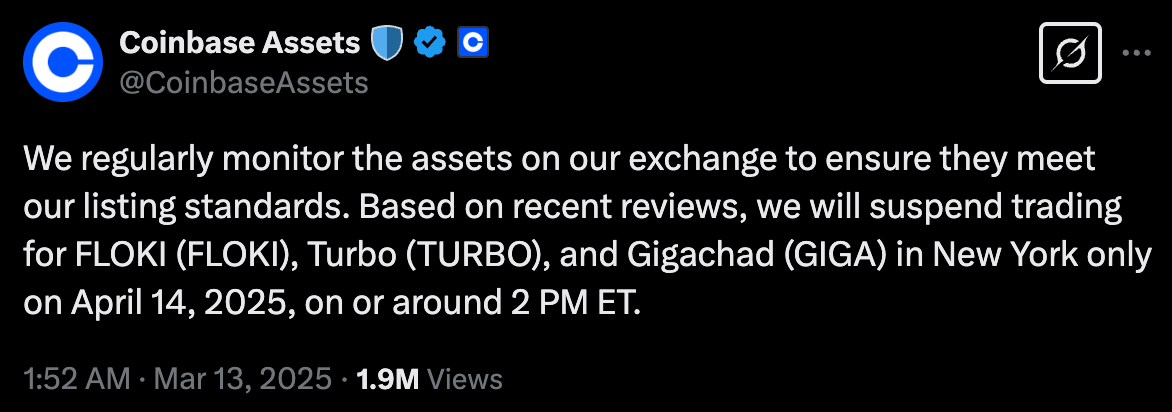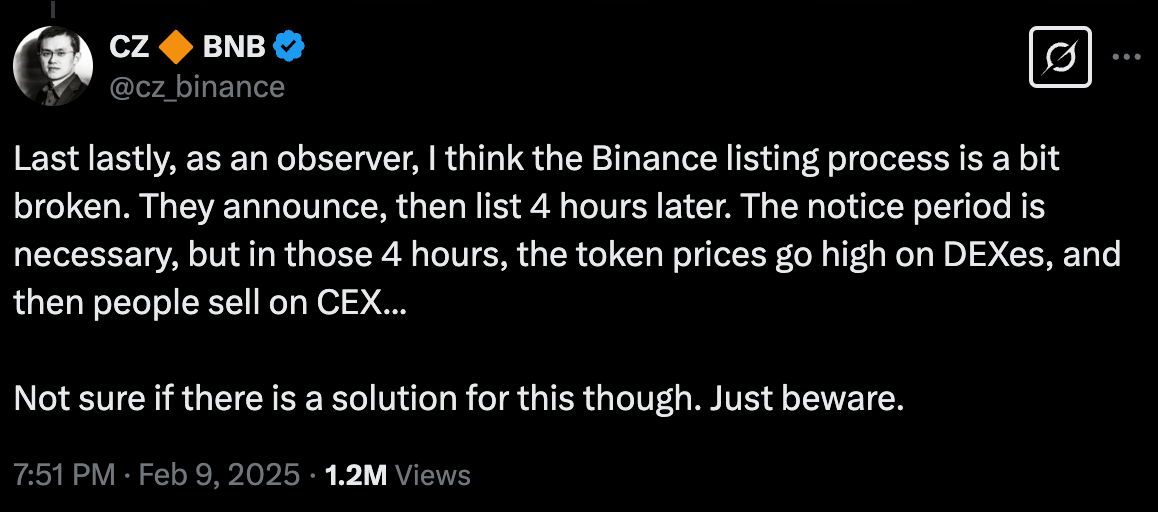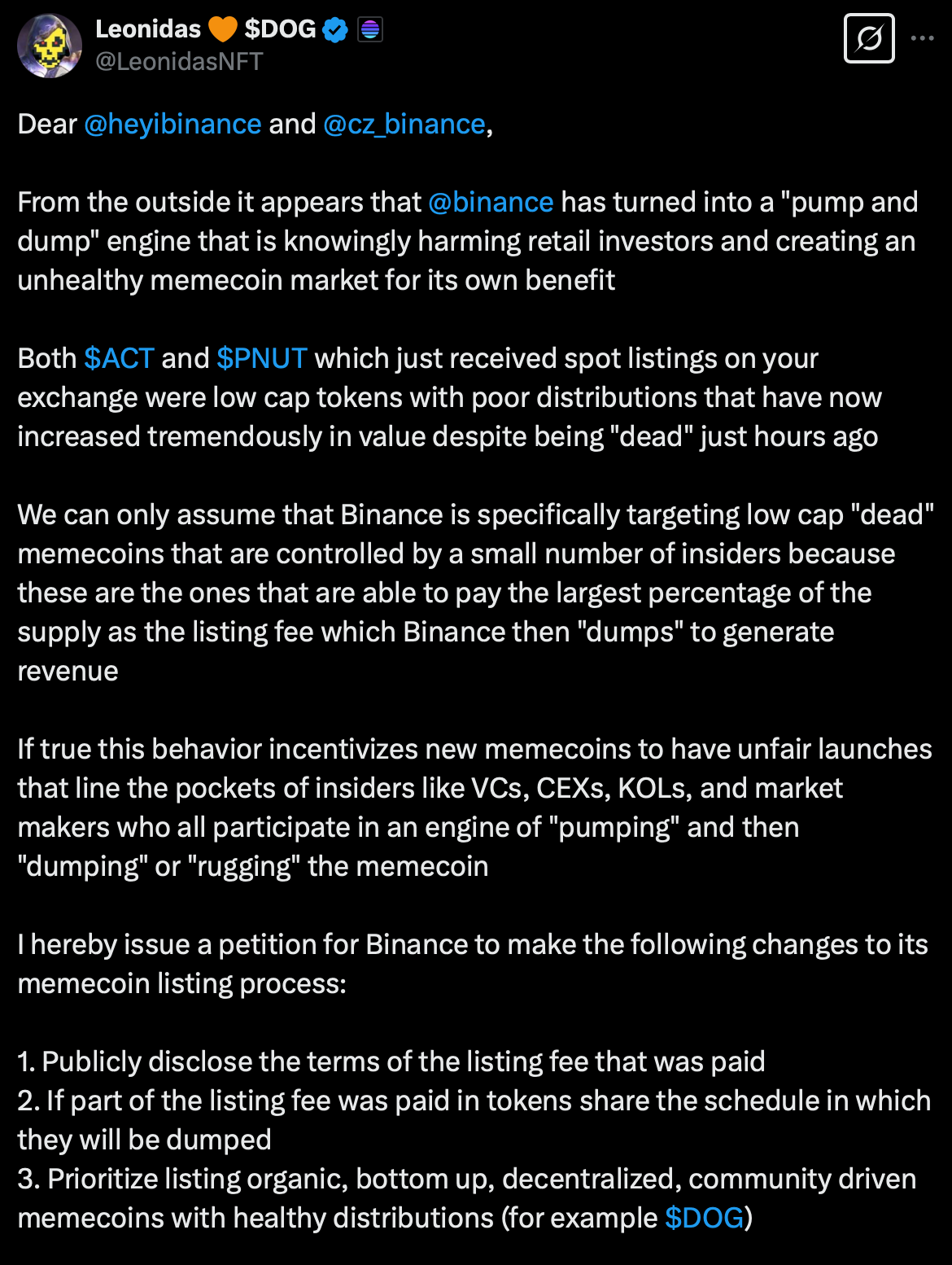Happy Sunday dispatchers!
"The definition of insanity is doing the same thing over and over again and expecting different results."
— Rita Mae Brown
You've seen this movie before: A token nobody heard of yesterday suddenly appears on Binance. It rockets 300% in the first hour. Crypto Twitter explodes with rocket emojis. Then gravity kicks in. Three days later, it's down 80% from the listing peak, and only insiders walked away with profits. Rinse and repeat.
Now the major exchanges want us to believe they've found the cure for a disease they helped create. Coinbase and Binance are rolling out flashy new listing mechanisms with all the fanfare of tech companies unveiling the next iPhone. Have they indeed solved anything, or just repackaged the same old problems in shiny new wrappers?
Let's pull back the curtain on crypto's oldest magic trick.
Stake Smarter, Stay Liquid – with Marinade Finance!
Why choose between earning staking rewards and keeping your SOL accessible? With Marinade Finance, you get the best of both worlds.
Stake SOL in seconds & earn rewards effortlessly
Stay liquid with mSOL—use it across Solana DeFi
Non-custodial & secure—your assets remain yours
Boost Solana’s security while maximising your yield
No lockups, no waiting—just smarter staking designed for flexibility and growth. Whether you're a DeFi pro or just getting started, Marinade makes staking seamless and rewarding.
Stake your SOL today with Marinade Finance!
If you're looking for proof that crypto markets haven't matured as much as we'd like to think, look no further than token listing announcements.
What happens when a new token lands on a major exchange like Binance or Coinbase? The pattern is so predictable it's almost comical: prices soar, insiders sell, retail investors hold the bag, and everyone acts surprised when the token collapses.
Last month, data from CoinGecko revealed that nearly every token listed on Binance since January has dropped at least 50% from its listing high, with most down 70-80%.
Something unusual is happening now. The exchanges themselves are finally admitting they might be part of the problem.
The Great Listing Overhaul
Binance announced on March 9 that it's implementing a community voting mechanism to determine which tokens get listed or delisted. Under this new system, Binance users will vote on projects, giving them a direct role in shaping the platform's offerings. Tokens receiving the most support and passing due diligence will be listed, while underperforming or non-compliant tokens could face removal.
Just days later, on March 12, they unveiled a "comprehensive token review framework" to automatically remove tokens that don't meet certain quantitative and qualitative criteria. These metrics include trading volume stability, liquidity depth, frequency of onchain transactions, tokenholders distribution, project team credibility, and adherence to regulatory compliance.
Coinbase, meanwhile, is floating an even more radical approach. CEO Brian Armstrong recently confessed that their manual review process has become completely unsustainable.
"We need to rethink our listing process at Coinbase, given there are ~1 million tokens a week being created now, and growing," Armstrong wrote on X in January.
His solution? A blocklist approach that would essentially crowdsource the filtering of scams through user reviews and automated scans of onchain data.
"It needs to move from an allow list to a block list and utilise customer reviews and automated scans of onchain data to help customers sift through," Armstrong argued, comparing the potential system to Twitter's Community Notes for crypto.
Get 17% discount on our annual plans and access our weekly premium features (HashedIn, Wormhole, Rabbit hole and Mempool) and subscribers only posts. Also, show us some love on Twitter and Telegram.
The Token Tsunami That Forced Their Hand
What prompted this dramatic shift in approach? The scale of token creation has exploded beyond anyone's wildest imagination.
We've rocketed from a few thousand tokens to over 12.5 million in just a few years, CoinMarketCap data showed. That's not a typo — 12.5 million different tokens are now floating around the crypto ecosystem, with the count increasing by roughly a million every week.
Of those millions, approximately 40,000 new memecoins launch daily on Solana alone. The Solana-based meme coin launchpad Pump.fun has spawned 8.5 million meme tokens since its launch in January 2024, according to Dune Analytics.
The factory is operating at full capacity, but quality control is nowhere to be found. Exchanges simply can't keep up with the volume using traditional vetting methods.
Even regulators are throwing up their hands. "Regulators need to understand that applying for approval for each one is totally infeasible at this point as well (they can't do 1m a week)," Armstrong noted in his post.
And yes, there’s always a pump. Infact, 80% of memecoins listed on Binance in 2024 experienced significant price increases, with Neiro (NEIRO) soaring nearly 7,600%. What happens then?
How bad has the situation been?
Read: Berachain: From Bears to Billions 🍯
The "Coinbase Effect" exemplifies this pattern perfectly. When Floki was added to Coinbase's listing roadmap in November, it shot to a five-month high. Turbo and Giga jumped 15% and 37% respectively after their listing announcements. In almost every case, the tokens subsequently stabilised at much lower levels, leaving late buyers underwater.
Now, Coinbase has stopped trading them.
Former Binance CEO Changpeng Zhao recently described the exchange listing process as "broken," noting that tokens often surge on decentralised exchanges before listing announcements, only to face massive selling pressure once they go live on major platforms.
This suggests that those with insider knowledge are buying ahead of listings and dumping on retail once the news goes public — a pattern that's played out so consistently that it raises serious questions about who these listings are actually serving.
Why Dump Always Follows Pump
Several factors contribute to this depressingly predictable cycle.
The most obvious explanation is that exchange listings provide an ideal exit opportunity for insiders and VCs. Without proper vesting restrictions, early backers can offload their holdings as soon as retail enthusiasm peaks, cashing out before any real market demand forms.
Limited initial supply is another factor. When a token debuts with restricted circulating supply, eager buyers drive prices up quickly. As more tokens become available through team unlocks or vesting schedules, the artificial scarcity disappears, and prices inevitably correct.
The biggest culprit is the manufactured hype cycle itself. Major exchanges like Binance command such enormous user bases that their brand recognition creates what one analyst described as a "casino effect" — traders rush in expecting explosive gains rather than focusing on sustainable value.
Some speculate that exchanges themselves may be benefiting from this pattern. Binance has faced allegations of wash trading and market-making tactics designed to inflate demand and trading volume, though the exchange maintains it has a "robust market surveillance framework that identifies and takes action against market abuse."
Follow The Money, Not The Memes
Will these new community voting mechanisms and review frameworks actually solve the problem? There are reasons to be sceptical.
The economics underpinning exchange listings reveal why reforms may prove challenging. Major exchanges have powerful financial incentives to maintain the status quo — listing fees can be enormous, and the trading volume generated by new listings drives significant revenue.
Binance's recent overhaul comes suspiciously close to a $2 billion investment from Abu Dhabi-based MGX announced on March 12. This marks the first institutional investment in the exchange's eight-year history, funded entirely through stablecoins. The timing suggests Binance may be cleaning house in anticipation of greater institutional scrutiny.
Critics remain unconvinced by the proposed changes. Pseudonymous analyst Leonidas recently initiated a petition challenging Binance's listing strategy, claiming it promotes pump-and-dump schemes that harm retail investors while favouring insiders.
The petition calls on Binance to disclose its listing fee terms publicly and specify whether any expenses are paid in tokens, along with planned token sales information.
Coinbase's proposed blocklist approach brings its own challenges. While a Twitter-style "Community Notes" for crypto might sound appealing, it assumes users can effectively identify problematic tokens before significant harm occurs — a tall order in a space where sophisticated scams and legitimate projects often look indistinguishable at early stages.
The Regulatory Wild Card
The industry's regulatory environment adds another layer of complexity. With Paul Atkins awaiting confirmation as the next Securities and Exchange Commission (SEC) chair following his nomination by Donald Trump, exchanges are anticipating a more favourable regulatory landscape. This optimism may be fuelling the listing frenzy.
What's particularly concerning is how exchanges are responding to these regulatory shifts. The widespread assumption that the SEC will take a lighter touch has spawned a flood of new token applications, including increasingly exotic ETFs for everything from Cardano to memecoins like TRUMP and BONK.
Some issuers have even filed for leveraged memecoin ETFs — products that would have been unthinkable under former SEC Chair Gary Gensler. The industry's excitement about regulatory changes may be blinding it to the reality that, as Morningstar's Bryan Armour noted, "A leadership change is definitely beneficial for crypto, but the SEC is still a regulator."
Coinbase's recent decision to suspend trading of FLOKI, TURBO, and GIGA in New York starting April 14 suggests regional regulators may step in where federal ones hesitate. Legal expert Ariel Givner speculated the move is "tied to a pending legal case in NY," indicating that state-level oversight could become more aggressive even as federal regulation relaxes.
Token Dispatch View 🔍
Let's be honest about what we're witnessing: exchanges slapping fresh paint on a crumbling structure and calling it renovation.
The fundamental problem remains untouched. We're still dealing with an excessive supply of tokens chasing a limited pool of investor capital. As long as launching a token remains the fastest way to raise money in crypto — and as long as exchanges profit from listing fees and trading volume — the pump-and-dump cycle isn't going anywhere.
Community voting and blocklists might filter out the most egregious scams, but they won't change the economic incentives driving the listing game. It's like asking wolves to vote on henhouse security — the system is working precisely as designed for those who benefit from it.
What we're not seeing is any meaningful discussion about vesting schedules, lock-up periods for early investors, or transparency requirements for token distribution. These are the actual mechanisms that might prevent the rapid dump after the initial pump, but they would cut directly into the profits of insiders and exchanges alike.
The bitter truth is that major exchanges have profited handsomely from the current system. Every new listing brings a surge of trading activity, fees, and attention — regardless of whether the token ultimately succeeds or fails. The economic incentives simply aren't aligned with long-term investor protection.
For retail traders, the message couldn't be clearer: when a token you've never heard of suddenly appears on a major exchange, assume you're late to the party. The quick gains you see in the first hours after listing have already been priced in by those who knew about it days or weeks before you did.
Or as Warren Buffett might put it: If you've been invited to the party, you're probably the exit liquidity.
The new boss looks different, but the song remains the same. Meet the new voting mechanism, same as the old listing process. Just don't expect different results.
Week That Was 📆
Thursday: How STABLE is the GENIUS Act? ⚖️
Wednesday: Market Meltdown Hits Altcoins 😨
Token Dispatch is a daily crypto newsletter handpicked and crafted with love by human bots. You can find all about us here 🙌
If you want to reach out to 200,000+ subscriber community of the Token Dispatch, you can explore the partnership opportunities with us.
Disclaimer: This newsletter contains sponsored content and affiliate links. All sponsored content is clearly marked. Opinions expressed by sponsors or in sponsored content are their own and do not necessarily reflect the views of this newsletter or its authors. We may receive compensation from featured products/services. Content is for informational purposes only, not financial advice. Trading crypto involves substantial risk - your capital is at risk. Do your own research.














